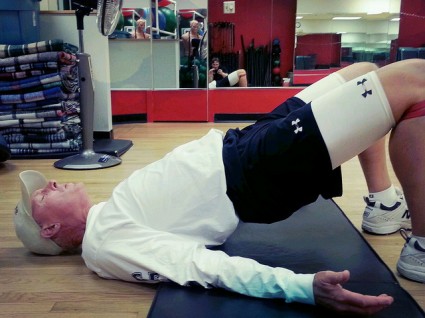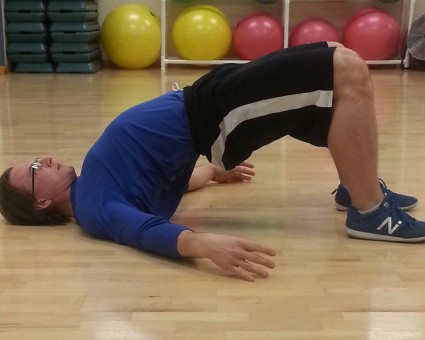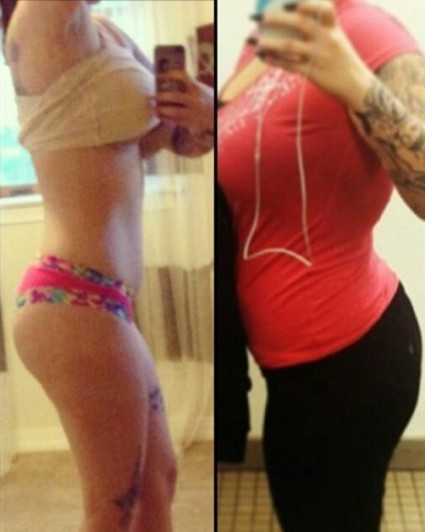“Ribs Down!”
Back pain: Virtually Everyone has it in Some Form at Some Time
Everyone.
My upper back around the base of my neck hurts if I sit here and work on this blog for too long.
My Lower back hurts if I stand for too long or sit (especially in my car) for a few consecutive hours.
I know what you’re thinking,
“Holy Sh@t, Yoda hurts Too?”
Yes, we ALL have default patterns and compensation patterns that have formed from them. One of mine is I “hang off the low back” sometimes, and when I do it for long enough, I get pain.
Look, when you’re training people, you’re standing….A LOT, and it’s easy to get into an “Extension” position and really crank on that low back using the hard structures to provide stability and stay upright.
Excessive extension at the Lumbar spine is a problem that I see a lot of. That’s probably because of the number of female clients I have. For some reason women seem to REALLY exaggerate this and live in this pattern.
Case in Point: Progress Picture one of my Online Clients posted to Facebook last week….
Pay attention to the low back on the right (at the start) versus now (left).
For the uninitiated…
LOOK AT THE BIG ASS LOWER BACK ARCH ON THE RIGHT.
As you can see Michelle is:
A: Putting in work and KILLING it.
B: WAAAAAAAAAAAAAAAAAAY less lordotic than she was.
ie. She’s NOT using the hard structures of the low back to provide stability anymore, instead she’s using her glutes, and abs more.
Granted, she’s not in a perfect position, the line of the belt buckle would still trend down now but it’s not going to be facing the ground anymore.
How to Stop Hanging Off the Low Back 101:
There are some basic things we need to do to clean up this pattern.
- Restore mobility in the thoracic spine and hips.
- Activate the Glutes, External obliques and Abs in general.
- Strengthen those areas.
1. Restore Mobility in the Thoracic Spine and Hips:
If the thoracic spine and hips are locked up we WILL NOT stop using the low back to create motion.
It’s as simple as that.
If we remain tight above and below the low back, the low back will become hypermobile and that’s where we’re going to look for stability when we get tired and need to find a place to “hang out”. So opening the thoracic spine and hips back up is the first thing we need to do.
Thoracic Extensions:
Thoracic Rotations:
Hip Circles:
Lateral Lunge:
Deep Squat:
2. Activate the Glutes, External Obliques and Abs in General.
These muscles probably are not doing a whole lot for you if “hanging off the low back” is your default pattern.
Why These Muscles are Important:
Glutes: They “set” the Pelvis. If the hips can’t get into the correct position everything above and below the belt line will have to compensate by moving from a neutral position.
Achieving neutral at the Lumbar or Throacic Spine as well as the Knees or Ankles is almost IMPOSSIBLE if the Pelvis isn’t in the correct position.
External Obliques: Strong External Obliques will help pull the rib cage down into a neutral position as well as help to strengthen the hips against lateral and rotary forces.
Think about is this way:
External Obliques Tie the Ribcage and Hips Together.
Abs (Anterior Core): The abs in general will help to provide the ability to “brace” against forces through the midsection. Without the ABS to “lock in” the neutral position, defaulting into lumbar extension will happen no matter how strong the glutes are.
Kelly Starrett put this best:
Glutes “set” the hips, Abs “set” the brace over the hips and the Obliques hold it all together.
These muscles may be developed and they may look like they’re doing something, but “functional” activation may not be going on here. It’s a case of,
“All Show and NO Go!”
If this is the case we really need to work on getting these muscles to fire, fire hard and activate on command and subconsciously.
An easy way to know if you can activate a muscle is:
Can You Flex That Muscle While in ANY Position?
If the answer is no, you don’t have optimal activation of that muscle and not only can you work towards improving activation of it, you probably should.
That said, simply being able to flex a muscle is the first step, and it’s easy for most people to squeeze their butt really hard. One cheek at a time selectively, that’s a different story and that’s what we need, SELECTIVE activation.
So an easy way to test for Glute activation is the quadraped hip extension exercise.
If the low back moves when you do this you’re creating too much movement there and are falling into a lumbar extension “default” pattern instead of actually, fully activating the Glutes.
Glute Activation Test Fail:
Glute Activation Test Pass:
Remember: It’s not the height of the heel that determines a passing grade here, it’s the movement, or rather, lack there of at the lower back that matters.
Glute Activation Exercises:
Glute Bridge:
This one is easy to “fake” and use low back movement to cover up a lack of hip extension and glute activation.


Good Lumbar neutral position. Incorrect “ribs up” position.
Mini Band Shuffle and or Monsterwalks:
Hip Thrust Isohold:
With both of these remember to keep the “Ribs Down” and “Tacked” into the abs.
External Oblique/ ABS Activation:
McGill Side Plank:
Plank:
3. Strengthen the Glutes, External Obliques and Anterior Core
Once the activation exercises become easy and you can actually SELECTIVELY squeeze those muscles you should move on to strengthening those areas.
Yes, this sometimes means PUTTING WEIGHT ON THE BAR…..it’s a shame but a lot of females still struggle with this notion.
Glute Strength:
Barbell Hip Thrust:
Barbell Glute Bridge:
One Leg Hip Thrust:
External Obliques:
With these, again, focus on not allowing the Ribs to “pop up”, stay “Tall and Tight”.
One Side Carries/ Farmers Walks:
Pallof Holds:
Tall Kneeling Rainbows:
Anterior Core:
When doing these always think ribs down and butt tight. Don’t EVER relax, always be tight and lock in at the lower back.
Ab Wheel:
Ball Plank Push-Aways:
TRX Fallouts:
With ALL of these exercises it’s important to remember to “GET TIGHT” and maintain a neutral spine throughout the exercises.
If you can’t, take some weight off the bar or regress the exercise to an easier version, but DO NOT allow the body to default into Lumbar Extension and “Hang off the Low Back”, that’ll only exacerbate the problem and make this pattern stronger and more difficult to de-program later.




Excellent article. I am going to try some of these exercises. I’ve been irritating my lower back doing romanian deadlifts. I think because i have such an excessive arch while doing them. Any tips for doing deads? I’ve been sticking to just goblet squats/front squats and this seems to straighten out my back. Anything similar I can do with deadlifts until I get this problem under control? I’m 35 and just realized I have this problem when I went to a PT with upper thoracic pain. I was never even aware of it before, but now that I’ve discovered this, alot of my bad form on certain exercises makes sense.
Nick,
How’s your thoracic mobility? Bracing is basically all the same. You need to create a “cylinder” effect through the core (lats to the bottom of the glutes) and maintain this. That said, based on your comment, it sounds like you’re lacking some thoracic spine mobility and because of that your body as found the needed mobility downstream at the lumbar spine and thats leading to you overarching. Off the top of my head I would work on:
1: Thoracic Mobility (Cat/camel stretch, Thoracic rotations, etc)
2: Bracing (tall kneeling, half kneeling, Palloff Press etc)
3: Glute activation/ Hip positioning: most likely maintaining external rotation at the femur (kneeouts, squats with bands above or below the knees, belt squat or band through belt marching)
I think that might help, but defer to your PT. He/ she has eyes and hands on you.
Thanks so much for this article – I’ve been struggling with tensions headaches, aching thorasic back, and extremely tight traps for a number of years, and I get the feeling the problem you’ve described is definitely one that’s causing my issues. I’ve got all the tools required due to trying numerous physios over the years, so will work on the exercises and see how I go! Cheers again!